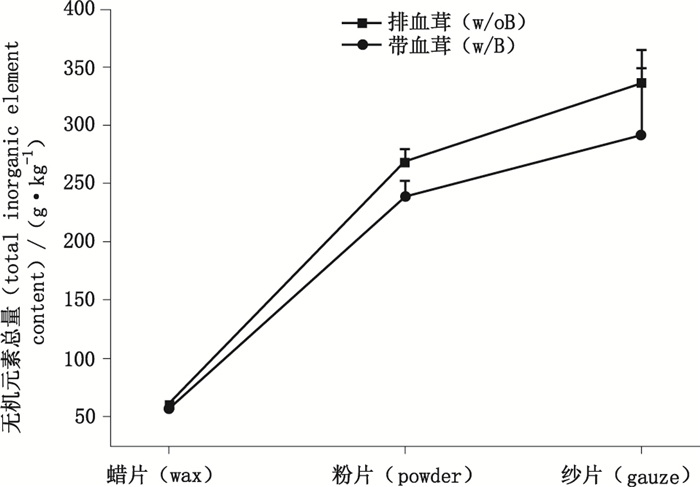2. 吉林农业大学中药材学院, 长春 130118
2. College of Traditional Chinese Medicine, Jilin Agricultural University, Changchun 130118, China
鹿茸是鹿科动物梅花鹿Cervus nippon Temminck或马鹿Cervus elaphus Linnaeus的雄鹿未骨化密生茸毛的幼角,性温,味甘、咸,具有壮肾阳、益精血、强筋骨、调冲任、托疮毒的功效[1]。鹿茸中含有丰富的氨基酸、多糖、脂肪酸、胆固醇、磷脂和矿物质等成分;现代医学研究表明,鹿茸具有免疫调节,抗肿瘤,抗疲劳,抗骨质疏松,抗炎,抗氧化,促进伤口愈合和再生的作用[2-3]。鹿茸是目前发现的唯一能够完全再生的哺乳动物器官,每年会周期性的脱落、再生,鹿角生长期内每天可以1~2 cm的速度生长,这段时期需要调动鹿全身的营养成分向鹿角部位聚集,其中矿物质元素便是必需营养成分之一[4]。汪树理等[5]研究表明鹿茸中无机元素的质量分数接近20%,是鹿茸发挥滋补壮阳、补气养血药效不可或缺的成分;其他学者也对鹿茸中的多种无机元素进行了检测,均表明鹿茸中含有丰富的无机元素[5-8]。
目前鹿茸的加工方法主要包括传统的沸水煮炸和较为先进的的冷冻干燥,根据加工前是否对鹿茸进行排血处理又可将鹿茸分为排血茸和带血茸。孟宪贞等[9]研究表明沸水煮炸和冷冻干燥2种加工方法对鹿茸中无机元素的含量有影响,但不同加工方式对鹿茸不同部位无机元素含量的影响尚未见报道。本研究通过对不同加工方式及不同部位的鹿茸无机元素的含量进行比较,旨在为鹿茸的加工及利用提供理论依据。
1 仪器与试药珀金埃尔默公司NexION 350X电感耦合等离子体质谱仪;耶拿分析仪器股份公司ZEEnit700原子吸收光谱仪;北京普析通用仪器有限责任公司PF6-3原子荧光分光光度计;耶拿分析仪器股份公司SPECORD 205紫外-可见分光光度计;梅特勒-托利多MS204S电子分析天平;上海元析仪器有限公司MWD-700型密闭式智能微波消解仪;密理博公司Milli-Q Advantage A10超纯水器。
硝酸、氢氧化钾、磷酸二氢钾、硼氢化钾均为优级纯试剂,北京化工厂;无水亚硫酸钠为分析纯,天津市福晨化学试剂厂;钼酸铵为分析纯,国药集团;对苯二酚为分析纯,北京市北郊化工厂;Cu、Zn、Mn、Fe、Ni、Co、Cr、Cd、Pb的多元素混合标准储备液以及K、Ca、Na、Mg、As、Hg的单元素标准储备液质量浓度均为1 000 μg·L-1,由国家有色金属及电子材料分析测试中心提供;超纯水(电阻率≥18.2 Ω)。
鲜鹿茸,由中国农业科学院特产研究所左家试验站提供,经中国农业科学院特产研究所李春义研究员鉴定为梅花鹿Cervus nipport Temminck的茸角(二杠)。
参考文献[10]的方法,随机选取其中3对进行排血茸(w/oB)与带血茸(w/B)的对比加工,另外3对进行煮炸(hot processing,H)与冷冻干燥(freeze-drying,F)的对比加工。将加工干燥后的鹿茸按照蜡片(wax slices,w)、粉片(powder slices,p)、纱片(gauze slices,g)分别进行切片、分段、粉碎、过筛(40目)、装袋、标记编号(见表 1)。
|
|
表 1 样品名称与简写符号 Table 1 Sample names and abbreviations |
准确称取样品粉末0.40 g,参考文献[11]的方法,加硝酸5 mL,按表 2所示微波消解程序对样品进行微波消解,消解液冷却至室温,转移至100 mL量瓶中,以超纯水洗涤消解罐2~3次,洗涤液转移至量瓶中,以超纯水定容,制得供试品溶液。同法制备空白试样。
|
|
表 2 微波消解程序 Table 2 Microwave digestion procedure |
准确量取一定体积的标准储备液,分别以2%硝酸定容,配成一系列梯度浓度的标准溶液,摇匀,备用;元素K、Ca、Na、Mg使用原子吸收光谱仪测定,元素Cu、Zn、Mn、Fe、Ni、Co、Cr、Cd、Pb使用电感耦合等离子体质谱仪测定。As、Hg元素标准溶液以2%硝酸分别梯度稀释至10 μg·L-1定容,摇匀,备用;元素As、Hg使用原子荧光分光光度计测定,10 μg·L-1标准溶液上机自动梯度稀释绘制标准曲线。元素P的测定参照标准GB 5009.87-2016,采用紫外-可见分光光度计于660 nm处测其吸收度。各元素线性回归方程、相关系数(r)及检出限见表 3。
|
|
表 3 元素线性回归方程、r及检出限 Table 3 Linear regression equation, r and detection limit of elements |
电感耦合等离子体质谱仪、原子吸收光谱仪、原子荧光分光光度计的工作参数分别见表 4~6。
|
|
表 4 电感耦合等离子体质谱仪工作参数 Table 4 Parameters of inductively coupled plasma mass spectrometry (ICP-MS) |
|
|
表 5 原子吸收光谱仪工作参数 Table 5 Parameters of atomic absorption spectrometer (AAS) |
|
|
表 6 原子荧光分光光度计工作参数 Table 6 Parameters of atomic fluorescence spectrometry (AFS) |
取排血茸与带血茸的供试品溶液,分别测定排血茸与带血茸无机元素的含量,结果见表 7。结果表明,元素Ca在排血茸与带血茸的蜡片、粉片、纱片部位的含量分别为12.55、170.28、230.56 g·kg-1和11.79、150.95、228.28 g·kg-1。同一加工方式的鹿茸元素Ca的含量呈现蜡片、粉片、纱片依次升高的趋势,且粉片、纱片部位明显高于蜡片部位,与王艳梅[8]的研究结果一致。元素Mg、P、Fe、Ni、Co在鹿茸不同部位的分布呈现与元素Ca相似的变化趋势。元素Cu、Mn、Cr在排血茸蜡片部位的含量分别为4.12、1.21、8.34 mg·kg-1,在带血茸蜡片部位的含量分别为4.22、1.50、16.72 mg·kg-1;这3种元素在鹿茸不同部位的分布均呈现与元素Ca相反的变化趋势,即蜡片、粉片、纱片依次降低,而且蜡片部位明显高于粉片、纱片部位。有毒有害元素Cd、Pb、Hg较多地分布于蜡片部位,这2种元素在排血茸蜡片部位的含量分别为11.81、291.57 μg·kg-1,在带血茸蜡片部位的含量分别为5.63、817.58 μg·kg-1。2种不同加工方式的鹿茸均未检测到元素As。
|
|
表 7 排血茸与带血茸无机元素的含量 Table 7 The contents of inorganic elements in antlers without and with blood |
图 1为排血茸与带血茸无机元素的含量。排血茸蜡片、粉片、纱片部位无机元素的含量分别为59.81、268.40、333.76 g·kg-1,纱片部位分别是蜡片、粉片部位的4.49倍和1.24倍。带血茸蜡片、粉片、纱片部位无机元素的含量分别为56.45、239.58、323.10 g·kg-1,纱片部位分别是蜡片、粉片部位的5.72倍和1.35倍。同一加工方式的鹿茸无机元素的含量呈现蜡片、粉片、纱片依次升高的趋势,且蜡片部位明显低于粉片、纱片部位。

|
图 1 排血茸(w/oB)与带血茸(w/B)无机元素总量的比较 Figure 1 Total content of inorganic elements in antlers without blood (w/oB)and with blood(w/B) |
取煮炸茸与冻干茸的供试品溶液,测定煮炸茸与冻干茸无机元素的含量,结果见表 8。元素K在煮炸茸蜡片、粉片、纱片部位的含量分别为10.73、9.03、6.34 g·kg-1,在冻干茸相应部位的含量分别为17.62、15.58、9.17 g·kg-1。同一加工方式的鹿茸元素K的含量呈现蜡片、粉片、纱片依次降低的趋势。元素Na在鹿茸不同部位的含量为16.60~23.42 g·kg-1,其在煮炸茸与冻干茸中的含量差异不明显,不同部位的分布差异也不大。元素Ca在煮炸茸蜡片、粉片、纱片部位的含量分别为19.87、189.40、251.78 g·kg-1,在冻干茸相应部位的含量分别为9.04、147.69、224.90 g·kg-1。元素Mg在煮炸茸蜡片、粉片、纱片的含量分别为1.66、4.94、5.70 g·kg-1,在冻干茸相应部位的含量分别为1.13、3.41、4.77 g·kg-1。2种加工方式的鹿茸元素Ca、Mg、P的含量均呈现蜡片、粉片、纱片依次升高的趋势。元素Fe、Ni、Co在不同部位的分布规律与元素Ca相似,即蜡片、粉片、纱片依次升高。元素Cu、Mn、Cr在不同部位的分布呈现与元素Ca相反的变化趋势,即蜡片、粉片、纱片依次降低。元素Zn在煮炸茸蜡片、粉片、纱片部位的含量分别为45.60、28.77、24.81 mg·kg-1,呈现蜡片、粉片、纱片依次降低的趋势;其在冻干茸蜡片、粉片、纱片部位的含量分别为32.16、32.84、27.41 mg·kg-1
|
|
表 8 煮炸茸与冻干茸无机元素的含量 Table 8 The contents of inorganic elements in antlers with boiling and freeze-drying processing |
图 2为煮炸茸与冻干茸无机元素的总量。煮炸茸蜡片、粉片、纱片部位无机元素的总量分别为78.74、278.92、348.37 g·kg-1,纱片部位分别是蜡片、粉片部位的4.42倍和1.25倍。冻干茸蜡片、粉片、纱片部位无机元素的含量分别为70.39、232.78、313.11 g·kg-1,纱片部位分别是蜡片、粉片部位的4.45倍和1.35倍。煮炸茸无机元素的含量高于冻干茸。同种加工方式的鹿茸蜡片、粉片、纱片部位无机元素的含量依次升高,而且蜡片部位明显低于粉片、纱片部位。

|
图 2 煮炸茸(H)与冻干茸(F)无机元素的总量 Figure 2 Total content of element content in antlers with hot processing (H)and freeze-drying processing(F) |
鹿茸是雄性梅花鹿或马鹿的颅骨附属物[12],属于骨组织。Buddhachat K等[13]研究认为,骨骼、茸角等矿化组织是动物储存元素的重要场所;郭彩玉等[14]研究发现,鹿茸顶端组织细密,未见成骨细胞,向下逐渐出现成骨细胞和骨细胞群,骨化面积逐渐扩大;又由于骨化是由于钙盐沉积导致的,因此鹿茸中元素Ca的含量呈现蜡片、粉片、纱片依次增加的趋势。元素Mg、P与Ca同为骨组织的主要成分,因此,在骨化程度较大的粉片、纱片分布较多,而在尚未骨化的蜡片部位分布很少。元素Fe、Ni、Co呈现与元素Ca相似的分布规律,可能是由于鹿茸的不同部位对这几种必需元素的呈现相近的需求规律。鹿茸无机元素的总量呈现蜡片、粉片、纱片依次升高的趋势,其中粉片部位约为蜡片部位的4倍,纱片部位约为蜡片部位的5倍。这与王艳梅[8]、Jeon B等[15]的研究结果一致。
排血茸中无机元素的总量高于带血茸,可能是由于鹿茸血液干物质中无机元素的含量相对较少。元素Fe是构成血红蛋白的重要组分,血液中含有丰富的Fe元素,因此带血茸中的Fe元素含量明显高于排血茸。煮炸茸中无机元素的总量高于冻干茸,可能是由于煮炸加工过程中部分血液流失,而血液中无机元素的含量较低,这也与排血茸中无机元素的含量高于带血茸的测试结果一致。Cu、Zn、Mn、Cr、Pb、Cd、Hg等重金属元素较多地分布在煮炸茸的蜡片部位,可能是由于鹿茸煮炸加工过程中顶部向下进行水煮,重金属元素更多地向蜡片部位集中,也可能与鹿茸的组织结构和生长发育过程有关。目前,野生鹿茸资源较少,市场上所售商品茸多为家养鹿产的茸,鹿茸中沉积的矿物质主要来源于鹿体骨骼及饲料[16-19],因此鹿茸中无机元素的含量与梅花鹿食用的饲料有一定的关系。
综上所述,鹿茸中无机元素的含量可能同时受其组织形态结构、生长发育状况、食物来源及加工方式的影响,不同加工方式的鹿茸其无机元素的分布有一定的差异。
| [1] |
中国药典2015年版. 一部[S]. 2015: 323 ChP 2015. Vol Ⅰ[S]. 2015: 323 |
| [2] |
SUI Z, ZHANG L, HUO Y, et al. Bioactive components of velvet antlers and their pharmacological properties[J]. J Pharm Biomed Anal, 2014, 87(18): 229. |
| [3] |
周冉, 李淑芬. RP-HPLC同时快速测定鹿茸中尿嘧啶、次黄嘌呤、尿苷含量[J]. 药物分析杂志, 2009, 29(4): 575. ZHOU R, LI SF. RP-HPLC simultaneous determination of three biological bases in antler velvet[J]. Chin J Pharm Anal, 2009, 29(4): 575. |
| [4] |
李春义. 鹿茸完全再生机制研究进展[J]. 农业生物技术学报, 2017, 25(1): 1. LI CY. Progress in the mechanism underlying full regeneration of mammalian organ deer antlers[J]. J Agric Biotechnol, 2017, 25(1): 1. |
| [5] |
汪树理, 孙继红, 李晓红, 等. 东北梅花鹿茸不同部位多糖与无机元素质量分数的差异[J]. 东北林业大学学报, 2008, 36(5): 58. WANG SL, SUN JH, LI XH, et al. Difference in contents of polysaccharide and some inorganic elements in different parts of northeast sika deer velvet[J]. J Northeast Forest Univ, 2008, 36(5): 58. |
| [6] |
董万超, 刘春华, 赵立波, 等. 马鹿茸、梅花鹿茸不同部位无机元素含量测定分析[J]. 特产研究, 2004, 26(3): 32. DONG WC, LIU CH, ZHAO LB, et al. Determination and analysis of inorganic element contents of different segments from wapiti and sika deer velvet antler[J]. Spec Wild Econ Anim Plant Res, 2004, 26(3): 32. |
| [7] |
商云帅, 刘晗璐, 刘继永, 等. 鹿茸和鹿肉中铅镉汞砷铜五种重金属含量检测分析[J]. 时珍国医国药, 2016, 27(3): 587. SHANG YS, LIU HL, LIU JY, et al. Detection and analysis of five heavy metals in deer velvet and venison[J]. Lishizhen Med Mater Med Res, 2016, 27(3): 587. |
| [8] |
王艳梅. 东北梅花鹿茸主要成分系统性比较研究[D]. 东北林业大学, 2004 WANG YM. A Systematic Comparative Study of Main Chemical Composition of Northeast Sika Deer(Cervus nippon hortutorum) Velvet[D]. Northeast Forest Univ, 2004 http://www.wanfangdata.com.cn/details/detail.do?_type=degree&id=Y632737 |
| [9] |
孟宪贞, 程晓薇, 陈力强. 冷冻干燥法与传统加工法制得的鹿茸化学成分分析及其比较研究[J]. 中国药房, 1997, 8(3): 110. MENG XZ, CHENG XW, CHEN LQ. A comparison of chemieal compositions of Cornu Cervi Pantotrichum proeessed by freeze-drying method with those by traditional method[J]. China Pharm, 1997, 8(3): 110. |
| [10] |
李和平, 王春生. 生态养鹿[M]. 北京: 中国农业出版社, 2011. LI HP, WANG CS. Ecological Deer[M]. Beijing: China Agriculture Press, 2011. |
| [11] |
姜英, 商云帅, 刘继永. 白花延龄草中8种无机营养元素测定分析[J]. 特产研究, 2015, 37(4): 36. JIANG Y, SHANG YS, LIU JY. Analysis of eight kinds of inorganic elements in Trillum kamtschaticum Pall[J]. Spec Wild Econ Anim Plant Res, 2015, 37(4): 36. |
| [12] |
ZHOU R, LI SF. In vitro antioxidant analysis and characterisation of antler velvet extract[J]. Food Chem, 2009, 114(4): 1321. DOI:10.1016/j.foodchem.2008.11.010 |
| [13] |
BUDDHACHAT K, KLINHOM S, SIENGDEE P, et al. Elemental analysis of bone, teeth, horn and antler in different animal species using non-invasive handheld X-ray fluorescence[J]. PloS One, 2016, 11(5): 1. |
| [14] |
郭彩玉, 徐力, 牛志多, 等. 鹿茸的组织学研究[J]. 特产研究, 1996(3): 18. GUO CY, XU L, NIU ZD, et al. The histological research of pilose antler[J]. Spec Wild Econ Anim Plant Res, 1996(3): 18. |
| [15] |
JEON B, KIM S, LEE S, et al. Effect of antler growth period on the chemical composition of velvet antler in sika deer (Cervus nippon)[J]. Mamm Biol, 2009, 74(5): 374. DOI:10.1016/j.mambio.2008.07.005 |
| [16] |
孙红梅, 李春义, 杨福合, 等. 鹿茸骨化机制的研究进展[J]. 草食家畜, 2009, 33(1): 1. SUN HM, LI CY, YANG FH, et al. Research progress of ossification mechanisms of antler[J]. J Herbivor Anim, 2009, 33(1): 1. |
| [17] |
ESTEVEZ JA, LANDETE-CASTILLEJOS T, MARTÍNEZ A, et al. Antler mineral composition of Iberian red deer Cervus elaphus hispanicus is related to mineral profile of diet[J]. Acta Theriol, 2009, 54(3): 235. DOI:10.4098/j.at.0001-7051.070.2008 |
| [18] |
CEACERO F, LANDETE-CASTILLEJOS T, GARCÍA AJ, et al. Free-choice mineral consumption in Iberian red deer (Cervus elaphus hispanicus) response to diet deficiencies[J]. Livest Sci, 2009, 122(2): 345. |
| [19] |
CEACERO F, LANDETE-CASTILLEJOS T, GARCÍA AJ, et al. Physiological variables explain mineral intake in Iberian red deer[J]. Physiol Behav, 2010, 100(2): 122. DOI:10.1016/j.physbeh.2010.02.008 |
 2018, Vol. 38
2018, Vol. 38 

